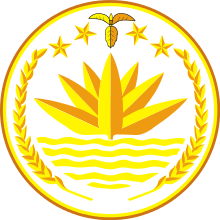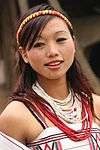Santal people
The Santal, or Santhal,[5] are an ethnic group native to India and Bangladesh in South Asia. Santals are the largest tribe in the Jharkhand state of India in terms of population and are also found in the states of Assam, Bihar, Odisha and West Bengal. They are the largest ethnic minority in northern Bangladesh's Rajshahi Division and Rangpur Division. They have a sizeable population in Nepal and Bhutan. The Santals mostly speak Santali, the most widely spoken of the Munda languages.
 | |
| Total population | |
|---|---|
| c. 7.4 million | |
| Regions with significant populations | |
| India • Bangladesh • Nepal | |
| Jharkhand 2,752,723[1] West Bengal 2,512,331[1] | |
| 300,061 (2001)[3] | |
| 42,698[4] | |
| Languages | |
| Santali | |
| Religion | |
| |
| Related ethnic groups | |
| Mundas • Hos • Juangs • Kharias • Savaras • Korku | |
History
According to linguist Paul Sidwell (2018), Austro-Asiatic language speakers probably arrived on coast of Odisha from Indochina about 4000–3500 years ago.[6] The Austroasiatic speaker spread from Southeast Asia and mixed extensively with local Indian populations.[7]
British officials intended to enhance the revenue by expansion of agriculture.[8] They encouraged the Paharia people of Rajmahal hills to practice settled agriculture but they refused to cut the trees. Then British officials turned their attention to Santals, who were ready to clear the forest for the practice of settled agriculture. In 1832, a large number of areas were demarcated as Damin-i-koh or Santal Pargana. Santals from Cuttack, Dhalbhum, Birbhum, Manbhum and Hazaribagh migrated and started cultivating these lands as peasants. British collected taxes from these Santals as revenue. The imposition of taxes, exploitation by Zamindars and money lenders sparked the Santal rebellion. Sidhu and Kanhu Murmu, two brothers led the Santals against the British but were defeated.[8][9][10]
Religion
In the Santal religion, the majority of reverence falls on a court of spirits (bonga), who handle different aspects of the world and who are placated with prayers and offerings in order to ward off evil influences. These spirits operate at the village, household, ancestor, and sub-clan level, along with evil spirits that cause disease and can inhabit village boundaries, mountains, water, tigers, and the forest. The bonga are intermediaries between noa puri (visible world) and hana puri (the invisible reality), the abode of a Creator. This creator is variously called Marang Buru (Supreme Deity or literally The Great Mountain) or Thakur Jiu (life giver), and is the "cause of all causes," making the Santal religion, in a deep sense, monotheistic as well as pantheistic.[11]
A characteristic feature of a Santal village is a sacred grove (known as the Jaher[12] or Santal Sthal) on the edge of the village where many spirits live and where a series of annual festivals take place.[13] Manjhi Than is another worship place for Santal tribes. There is a tradition of having one Manjhi Than in a Santal village.
A yearly round of rituals connected with the agricultural cycle, along with life-cycle rituals for birth, marriage and burial at death, involve petitions to the spirits and offerings that include the sacrifice of animals, usually birds. Religious leaders are male specialists in medical cures who practice divination and witchcraft (the socio-historic meaning of the term, used here, refers to the ritual practice of magic and is not pejorative). Similar beliefs are common among other tribes of northeast and central India such as the Kharia, Munda, and Oraon.[13]
Smaller and more isolated tribes often demonstrate articulated classification systems of the spiritual hierarchy less well documented, described as animism or a generalised worship of spiritual energies connected with locations, activities, and social groups. Religious concepts are intricately entwined with ideas about nature and interaction with local ecological systems. As in Santal religion, religious specialists are drawn from the village or family and serve a wide range of spiritual functions that focus on placating potentially dangerous spirits and co-ordinating rituals.[13]
According to the 2011 Indian Census, majority of the Santal's from Jharkhand follow Hinduism at 54%, with 37% following "other religions and persuasions". Christianity is practised by 8.3% present of the population. Islam, Sikhism, Buddhism and Jainism are followed by less than 1% of the population.[14]
Culture

Sohrai is the principal festival of Santal community. Besides that Baha, Karam, Dansai, Sakrat, Mahmore, Rundo and Magsim are important festivals. The Santal traditionally accompany many of their dances during these festivals with two drums: the Tamak‘ and the Tumdak’.[15]

Chadar Badar, a form of puppetry known also as Santal puppetry, is a folk show involving wooden puppets placed in a small cage which acts as the stage.
Originally hunter-gatherers, Santals made a transition to agrarian lifestyle. Decision-making matters is done through a village council which is headed by a person titled manjhi. The manjhi is aided by other council members to carry out and deal with local affairs.[16]
Santal art is noticeable for its intricate carving style. The walls of traditional Santal homes are ornamented with carved designs of animals, hunting scenes, dancing scenes, geometric patterns, and more. Santal styled Palanquins were also finely carved and designed.[16]

Notable people
- Chami Murmu,(born c.1973) a recipient of Nari Shakti Puraskar award in 2020.
- Chandrani Murmu (born 16 June 1993) is an Indian politician, a youngest Indian Member of Parliament,from Keonjhar, Odisha in the 2019 Indian general election as a member of the Biju Janata Dal.
- Khagen Murmu,(born 2 February 1960) an Indian politician and a Member of Parliament from Maldaha Uttar (Lok Sabha constituency).
- Birbaha Hansda, Santali-language actress[17]
- Rathin Kisku, Baul singer.[18]
- Babulal Marandi, first chief minister of Jharkhand[19]
- Draupadi Murmu, Governor of Jharkhand[20]
- G. C. Murmu, first lieutenant governor of J&K (union territory)[21]
- Salkhan Murmu, Indian socio-political activist
- Sidhu and Kanhu Murmu, freedom fighter[22]
- Uma Saren, Politician, MP from Jhargram[23]
- Hemant Soren, Chief Minister of Jharkhand[24]
- Shibu Soren, former chief minister of Jharkhand and president of Jharkhand Mukti Morcha[24]
- Raghunath Murmu, Inventor of Ol-Chiki script.
- Bhagwat Murmu, A Social Worker, First recipient of Padma Shri Award among Santal People,Awarded on 16th March 1985 [25][26] Member of Bihar Legislative Assembly, 1957-1962 [27].
References
![]()
- "A-11 Individual Scheduled Tribe Primary Census Abstract Data and its Appendix". www.censusindia.gov.in. Office of the Registrar General & Census Commissioner, India. Retrieved 18 November 2017.
- "C-16 Population By Mother Tongue". www.censusindia.gov.in. Office of the Registrar General & Census Commissioner, India. Retrieved 3 November 2019.
- Cavallaro, Francesco; Rahman, Tania. "The Santals of Bangladesh" (PDF). ntu.edu.sg. Nayang Technical University. Retrieved 17 November 2017.
- "Santali: Also spoken in Nepal". Retrieved 1 April 2011.
- Bisoee, Animesh (28 May 2019). "Brave show of support for arrested Santhal". The Telegraph. Retrieved 31 May 2019.
- Sidwell, Paul. 2018. Austroasiatic Studies: state of the art in 2018. Presentation at the Graduate Institute of Linguistics, National Tsing Hua University, Taiwan, 22 May 2018.
- Schliesinger, Joachim (2016). Origin of the Tai People 3: Genetic and Archaeological Approaches. Booksmango. p. 71. ISBN 9781633239623. Retrieved 30 September 2019.
- Jha, Amar Nath (2009). "Locating the Ancient History of Santal Parganas". Proceedings of the Indian History Congress. 70: 185–196. ISSN 2249-1937. JSTOR 44147668.
- This is Our Homeland: A Collection of Essays on the Betrayal of Adivasi. 2007. Retrieved 26 August 2019.
- Malik, Dr Malti (1943). History of India. ISBN 9788173354984. Retrieved 26 August 2019.
- Debnath, Mrinal Kanti (28 February 2011). Living on the Edge: The Predicament of a Rural Indigenous Santal Community in Bangladesh (Thesis thesis).
- "Jaher Worshiping Place of Santals". Retrieved 27 September 2014.
- "The Green Revolution in India". U.S. Library of Congress Country Studies (released in public domain). Retrieved 6 October 2007.
- "ST-14 Scheduled Tribe Population By Religious Community - Jharkhand". census.gov.in. Retrieved 3 November 2019.
- "Chadar Badar". Telegraph. 2015. Retrieved 22 March 2015.
- Winston, Robert, ed. (2004). Human: The Definitive Visual Guide. New York: Dorling Kindersley. p. 440. ISBN 0-7566-0520-2.
- Das, Madhuparna (2 April 2016). "Santhali actress Birbaha Hansda to fight West Bengal polls". The Economic Times. Retrieved 8 January 2020.
- "Baul international". The Telegraph. 18 November 2007. Retrieved 26 March 2020.
- "जिस BJP को दिलाई थी करिश्माई जीत, बाबूलाल मरांडी का उसी से हुआ मोहभंग". aajtak.intoday. 1 April 2019.
- "Draupadi Murmu may soon be the President of India: Know all about her". indiatoday.
- Das, Anand ST (1 November 2019). "'A Tribal Boy Got a Big Opportunity': GC Murmu's Mother Elated over His Appointment as J&K's L-G". News18. Retrieved 19 February 2020.
- Sailendra Nath Sen (2010). An Advanced History of Modern India. Macmillan. p. 120. ISBN 9780230328853.
- Seetharaman, G.; Balasubramanyam, K. R. (25 May 2014). "32 newly elected under-35 MPs & what they intend to do for their constituencies". The Economic Times. Retrieved 14 March 2019.
- "Shibu Soren". Britannica. Retrieved 3 February 2020.
- List of Padma Shri award recipients (1980–1989)
- Padma Awards, Ministry of Home Affairs, Govt. of India
- About Jhajha Legislative Assembly (Vidhan Sabha) Constituency
Bibliography
- Archer, W. G. The Hill of Flutes: Life, Love, and Poetry in Tribal India: A Portrait of the Santals. Pittsburgh: University of Pittsburgh Press, 1974.
- Bodding, P. O. Santal Folk Tales. Cambridge, Massachusetts: H. Aschehoug; Harvard University Press, 1925.
- Bodding, P. O. Santal Riddles and Witchcraft among the Santals. Oslo: A. W. Brøggers, 1940.
- Bodding, P. O. A Santal Dictionary (5 volumes), 1933–36 Oslo: J. Dybwad, 1929.
- Bodding, P. O. Materials for a Santali Grammar I, Dumka 1922
- Bodding, P. O. Studies in Santal Medicine and Connected Folklore (3 volumes), 1925–40
- Bompas, Cecil Henry, and Bodding, P. O. Folklore of the Santal Parganas. London: D. Nutt, 1909. Full text at Project Gutenberg.
- Chakrabarti, Dr. Byomkes, A Comparative Study of Santali and Bengali, KP Bagchi, Calcutta, 1994
- Culshaw, W. J. Tribal Heritage; a Study of the Santals. London: Lutterworth Press, 1949.
- Edward Duyker Tribal Guerrillas: The Santals of West Bengal and the Naxalite Movement, Oxford University Press, New Delhi, 1987, pp. 201, SBN 19 561938 2.
- Hembrom. T, The Santals: Anthropological-Theological Reflections on Santali & Biblical Creation Traditions. 1st ed. Calcutta: Punthi Pustak, 1996.
- Orans, Martin. "The Santal; a Tribe in Search of a Great Tradition." Based on thesis, University of Chicago., Wayne State University Press, 1965.
- Prasad, Onkar. Santal Music: A Study in Pattern and Process of Cultural Persistence, Tribal Studies of India Series; T 115. New Delhi: Inter-India Publications, 1985.
- Roy Chaudhury, Indu. Folk Tales of the Santals. 1st ed. Folk Tales of India Series, 13. New Delhi: Sterling Publishers, 1973.
- Troisi, J. The Santals: A Classified and Annotated Bibliography. New Delhi: Manohar Book Service, 1976.
- ———. Tribal Religion: Religious Beliefs and Practices among the Santals. New Delhi: Manohar, 2000.
External links
| Wikimedia Commons has media related to Santal. |
| Wikisource has the text of the 1905 New International Encyclopedia article Santals. |
- Saontal Voice in Bangladesh
- Santal Rebellion
- Santal Engineers' Welfare Association – Working for all round development of Adivasi
- All India Santal Welfare and Cultural Society
- Santal Arts
- Santal Dance
- Boro Baski: Santal worries
- Santal culture on Daricha Foundation website (Kolkata)
- Banam The bowed music instrument played by the Santals
- RWAAI | RWAAI, Lunds universitet RWAAI (Repository and Workspace for Austroasiatic Intangible Heritage)
- http://hdl.handle.net/10050/00-0000-0000-0003-A6AF-2@view Santali language in RWAAI Digital Archive

